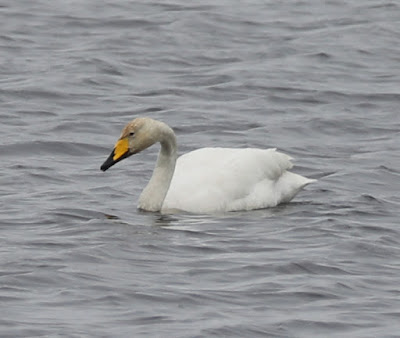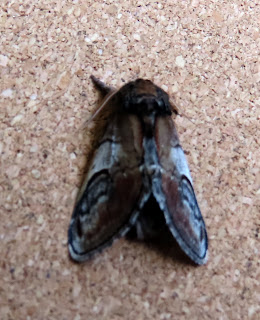Turn the Light On Please
Monday May 16
Sue and Ian calling round to return the borrowed portable moth trap enlivened the morning. They'd caught one moth last night, none the night before. This one a Shark - which we've never caught in our garden although others have. Our MV had another lovely female Emperor Moth. The caterpillars from the first caught, continue to eat voraciously, growing by the day.
Despite the rain, we still went out, south to Benbecula. Stinky Bay had a host of Eiders, no gulls, nor waders. Arctic Terns, Mute Swans, and a pair of Wigeon on the phalarope loch. On to the bigger Co-op a few miles away at Creagarry. Where next? Maybe The Range area.
We turned off the A 865 where it's signposted Hebridean Jewellery (I haven't been tempted yet), where there is a loch. Previously there were four, now there are three, summering Whooper Swans. As is usual, their necks are stained deep yellow from the peaty water.
What we call the very Stinky Bay, wasn't to-day. We parked on a grassy verge, ate our afternoon snack, and watched the myriad Dunlin, Sanderling, Turnstone, and Ringed Plover along the shoreline, and on the heaps of rotting seaweed. It was only when they sprang into flight that I became aware of how many birds there were. An extensive cloud. A typical shoreline scene from a distance.
The Sanderling are ginger brown on their backs and bibs, looking like Little Stints with longer beaks. The Dunlin's smart black belly make them stand out as does the bright chestnut and black of the summer Turnstone. I guess that most of the Ringed Plover are of the Arctic sub species. C. h. tundrae – :
breeds in Arctic northern Scandinavia and Asiatic Russia; winters in
Africa and southwest Asia. It is the smallest and darkest subspecies. Possibly also psammodroma,
which breeds no further away than Iceland, with its range extending to
Greenland and north-east Canada. Both races are very similar, being
slightly smaller, darker and marginally smaller-billed than our ‘own’
nominate race hiaticula .
A last look at the phalarope loch on the way home. No birds at all, the two cars of birders already present were packing up. We drove on to turn round. Pam pulled in again as we passed - in time to see a female Red-necked Phalarope drop onto the loch, stay a few seconds, and immediately fly off high again, towards Loch Fada. Lucky.
As I was watching Monkey World on my laptop after dinner, Pam came rushing in to point out a Short-eared Owl hunting the fence line of the field across the road. It had stopped raining.






Comments
Post a Comment